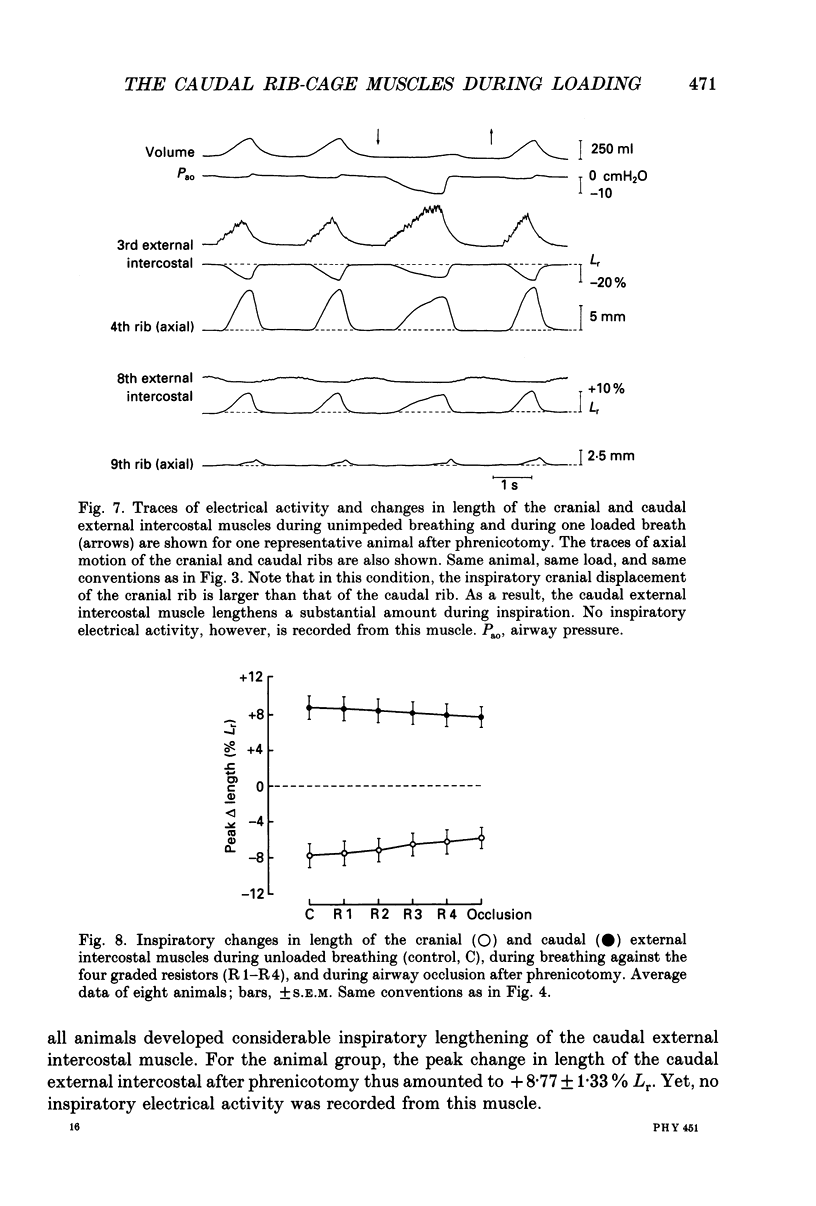Abstract
1. The effect of graded increases in inspiratory airflow resistance and airway occlusion on the electrical activity and the mechanical behaviour of the levator costae and external intercostal muscles situated in the caudal interspaces (zone of apposition of the diaphragm to the rib-cage) has been studied in spontaneously breathing dogs. 2. The external intercostal and levator costae muscles in the cranial interspaces were invariably active during unloaded inspiration and showed progressive facilitation of activity with increases in inspiratory resistance. In contrast, whether in the supine or in the prone position, the levator costae muscles of the caudal interspaces did not show any facilitation of activity, and the caudal external intercostal muscles never showed any inspiratory electrical activity, including during airway occlusion. 3. With graded increases in inspiratory airflow resistance, the cranial external intercostals demonstrated a gradual inspiratory lengthening and the cranial ribs were progressively displaced in the caudal direction. The caudal ribs, however, were invariably displaced in the cranial direction. As a result, the caudal external intercostals showed a progressive inspiratory shortening. 4. Shortening of the caudal external intercostals and cranial displacement of the caudal ribs were reproduced by isolated stimulation of the phrenic nerves. Thus, as inspiratory resistance increases, contraction of the diaphragm causes unloading, rather than loading, of the spindles present in the caudal external intercostal muscles. 5. After the phrenic nerves were sectioned, however, the caudal external intercostals invariably lengthened a substantial amount during inspiration, but they still did not show any inspiratory electrical activity. Accentuating the inspiratory lengthening of these muscles by external rib fixation and increasing the chemical respiratory drive did not elicit any inspiratory electrical activity either. The alpha-motoneurones of the external intercostal muscles in the caudal interspaces thus have very small central respiratory drive potentials with respect to their critical firing threshold.
Full text
PDF













Selected References
These references are in PubMed. This may not be the complete list of references from this article.
- Bainton C. R., Kirkwood P. A., Sears T. A. On the transmission of the stimulating effects of carbon dioxide to the muscles of respiration. J Physiol. 1978 Jul;280:249–272. doi: 10.1113/jphysiol.1978.sp012383. [DOI] [PMC free article] [PubMed] [Google Scholar]
- CORDA M., EKLUND G., VON EULER EXTERNAL INTERCOSTAL AND PHRENIC ALPHA-MOTOR RESPONSES TO CHANGES IN RESPIRATORY LOAD. Acta Physiol Scand. 1965 Mar;63:391–400. doi: 10.1111/j.1748-1716.1965.tb04079.x. [DOI] [PubMed] [Google Scholar]
- D'Angelo E., Sant'Ambrogio G. Direct action of contracting diaphragm on the rib cage in rabbits and dogs. J Appl Physiol. 1974 Jun;36(6):715–719. doi: 10.1152/jappl.1974.36.6.715. [DOI] [PubMed] [Google Scholar]
- De Troyer A. Differential control of the inspiratory intercostal muscles during airway occlusion in the dog. J Physiol. 1991 Aug;439:73–88. doi: 10.1113/jphysiol.1991.sp018657. [DOI] [PMC free article] [PubMed] [Google Scholar]
- De Troyer A., Ninane V. Respiratory function of intercostal muscles in supine dog: an electromyographic study. J Appl Physiol (1985) 1986 May;60(5):1692–1699. doi: 10.1152/jappl.1986.60.5.1692. [DOI] [PubMed] [Google Scholar]
- De Troyer A., Sampson M., Sigrist S., Macklem P. T. Action of costal and crural parts of the diaphragm on the rib cage in dog. J Appl Physiol Respir Environ Exerc Physiol. 1982 Jul;53(1):30–39. doi: 10.1152/jappl.1982.53.1.30. [DOI] [PubMed] [Google Scholar]
- De Troyer A. The electro-mechanical response of canine inspiratory intercostal muscles to increased resistance: the cranial rib-cage. J Physiol. 1992;451:445–461. doi: 10.1113/jphysiol.1992.sp019172. [DOI] [PMC free article] [PubMed] [Google Scholar]
- Duron B., Jung-Caillol M. C., Marlot D. Myelinated nerve fiber supply and muscle spindles in the respiratory muscles of cat: quantitative study. Anat Embryol (Berl) 1978 Feb 20;152(2):171–192. doi: 10.1007/BF00315923. [DOI] [PubMed] [Google Scholar]
- ECCLES R. M., SEARS T. A., SHEALY C. N. Intra-cellular recording from respiratory motoneurones of the thoracic spinal cord of the cat. Nature. 1962 Mar 3;193:844–846. doi: 10.1038/193844a0. [DOI] [PubMed] [Google Scholar]
- Greer J. J., Martin T. P. Distribution of muscle fiber types and EMG activity in cat intercostal muscles. J Appl Physiol (1985) 1990 Oct;69(4):1208–1211. doi: 10.1152/jappl.1990.69.4.1208. [DOI] [PubMed] [Google Scholar]
- Jiang T. X., Demedts M., Decramer M. Mechanical coupling of upper and lower canine rib cages and its functional significance. J Appl Physiol (1985) 1988 Feb;64(2):620–626. doi: 10.1152/jappl.1988.64.2.620. [DOI] [PubMed] [Google Scholar]
- Loring S. H., Mead J. Action of the diaphragm on the rib cage inferred from a force-balance analysis. J Appl Physiol Respir Environ Exerc Physiol. 1982 Sep;53(3):756–760. doi: 10.1152/jappl.1982.53.3.756. [DOI] [PubMed] [Google Scholar]
- SEARS T. A. THE SLOW POTENTIALS OF THORACIC RESPIRATORY MOTONEURONES AND THEIR RELATION TO BREATHING. J Physiol. 1964 Dec;175:404–424. doi: 10.1113/jphysiol.1964.sp007524. [DOI] [PMC free article] [PubMed] [Google Scholar]
- Sant'Ambrogio G., Widdicombe J. G. Respiratory reflexes acting on the diaphragm and inspiratory intercostal muscle of the rabbit. J Physiol. 1965 Oct;180(4):766–779. doi: 10.1113/jphysiol.1965.sp007730. [DOI] [PMC free article] [PubMed] [Google Scholar]
- Shannon R., Zechman F. W. The reflex and mechanical response of the inspiratory muscles to an increased airflow resistance. Respir Physiol. 1972 Sep;16(1):51–69. doi: 10.1016/0034-5687(72)90088-6. [DOI] [PubMed] [Google Scholar]


